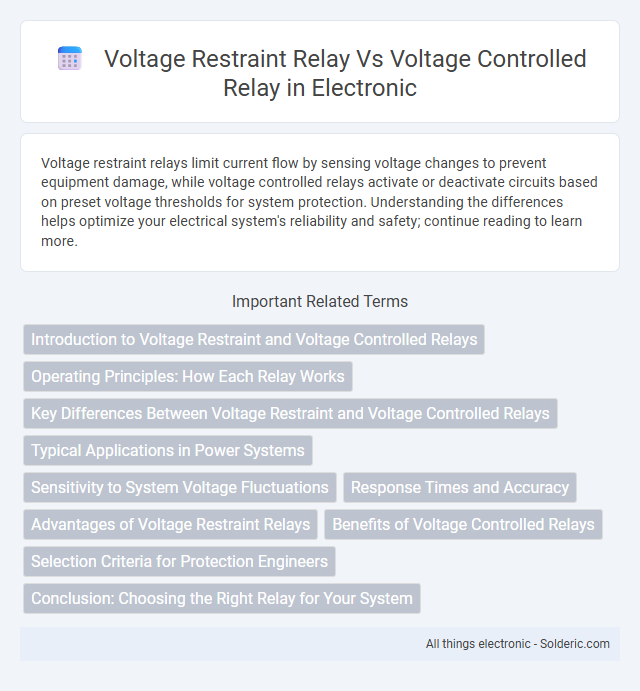Voltage restraint relays limit current flow by sensing voltage changes to prevent equipment damage, while voltage controlled relays activate or deactivate circuits based on preset voltage thresholds for system protection. Understanding the differences helps optimize your electrical system's reliability and safety; continue reading to learn more.
Comparison Table
| Feature | Voltage Restraint Relay | Voltage Controlled Relay |
|---|---|---|
| Function | Restrains tripping based on voltage conditions | Operates or trips directly on voltage levels |
| Application | Used in protection schemes to prevent false trips | Used where voltage threshold controls operation |
| Operation Principle | Allows current or other signals only when voltage is within set limits | Triggers action when voltage crosses preset value |
| Common Use | Fault detection in power systems requiring coordinated operation | Voltage monitoring and control in power systems |
| Response Time | Depends on combined voltage and current conditions | Typically faster, based on voltage threshold |
| Complexity | More complex due to combined measurements | Simpler, based on single voltage parameter |
Introduction to Voltage Restraint and Voltage Controlled Relays
Voltage restraint relays are designed to limit or restrain the voltage within specific thresholds to protect electrical equipment from overvoltage conditions. Voltage controlled relays operate by activating or deactivating circuits based on preset voltage levels, ensuring precise control of power systems and preventing damage due to voltage fluctuations. Both relay types enhance system stability and safeguard electrical components in various industrial and utility applications.
Operating Principles: How Each Relay Works
A voltage restraint relay operates by monitoring voltage levels and restraining tripping when the voltage is within a preset range, ensuring stability during transient conditions. A voltage controlled relay, however, functions by activating or deactivating based on a specific voltage threshold being reached, providing direct control over connected equipment at designated voltage points. Your choice between these relays depends on whether you need to prevent unwanted tripping during normal fluctuations or require precise voltage-based switching control.
Key Differences Between Voltage Restraint and Voltage Controlled Relays
Voltage restraint relays react to sudden voltage changes by temporarily blocking operation to prevent false tripping during transient conditions, whereas voltage controlled relays operate based on voltage level thresholds to initiate or inhibit protection functions. Voltage restraint relays are primarily employed to stabilize relay response during fault conditions with fluctuating voltages, while voltage controlled relays manage overall system voltage levels to maintain operational limits. The key difference lies in their control mechanism: restraint relays modulate relay sensitivity based on voltage changes, whereas controlled relays directly use voltage magnitude as a trigger for protective actions.
Typical Applications in Power Systems
Voltage restraint relays are commonly used in power system protection to prevent false tripping during transient voltage changes, such as motor starting or voltage dips, ensuring system stability. Voltage controlled relays, on the other hand, actively monitor voltage levels to initiate control actions like load shedding or capacitor switching during under-voltage or over-voltage conditions. Your power system benefits from using voltage restraint relays in fault-sensitive areas and voltage controlled relays where dynamic voltage regulation is required.
Sensitivity to System Voltage Fluctuations
Voltage restraint relays exhibit lower sensitivity to system voltage fluctuations, maintaining consistent operation by restraining relay activation during minor voltage variations to prevent false tripping. Voltage controlled relays respond more directly to specific voltage thresholds, making them highly sensitive to instantaneous voltage changes and suitable for applications requiring precise voltage monitoring. Your choice depends on whether you prioritize stability against transient voltage swings or rapid response to voltage deviations in protection schemes.
Response Times and Accuracy
Voltage restraint relays exhibit faster response times by quickly detecting abnormal voltage deviations and limiting relay operation to prevent nuisance tripping during transient disturbances. Voltage controlled relays offer higher accuracy in maintaining voltage thresholds, utilizing precise voltage sensing to activate only when specific voltage levels are sustained. The choice depends on system requirements for rapid detection versus precise voltage control to optimize protection and stability.
Advantages of Voltage Restraint Relays
Voltage restraint relays offer enhanced protection by dynamically adjusting to voltage fluctuations, reducing false tripping during transient conditions. Their sensitivity to voltage changes allows precise fault detection, improving system stability and minimizing unnecessary outages. These relays also provide better coordination with other protective devices, optimizing overall grid reliability and operational efficiency.
Benefits of Voltage Controlled Relays
Voltage controlled relays offer precise voltage regulation, enhancing the protection of electrical equipment by preventing overvoltage and undervoltage conditions. Their ability to rapidly respond to voltage fluctuations improves system stability and reduces the risk of equipment damage, ensuring reliable operation. By using voltage controlled relays, your electrical systems maintain optimal performance and safety, minimizing downtime and maintenance costs.
Selection Criteria for Protection Engineers
Selection criteria for protection engineers when choosing between voltage restraint relays and voltage controlled relays emphasize system stability, fault detection sensitivity, and operational context. Voltage restraint relays provide enhanced discrimination during power swings by restraining operation when voltage variations fall within preset limits, making them ideal for complex transmission networks. Voltage controlled relays are preferred for direct voltage threshold monitoring to quickly isolate faults, especially in simpler or distribution-level systems requiring fast tripping response.
Conclusion: Choosing the Right Relay for Your System
Voltage restraint relays are designed to limit fault current by reducing relay sensitivity when voltage exceeds a certain threshold, enhancing system stability during faults. Voltage controlled relays respond dynamically to voltage changes, providing precise control in protective schemes by activating or deactivating based on voltage conditions. Your choice depends on the specific protection requirements of your system, prioritizing fault current limitation with voltage restraint relays or accurate voltage-based operation with voltage controlled relays.
voltage restraint relay vs voltage controlled relay Infographic

 solderic.com
solderic.com